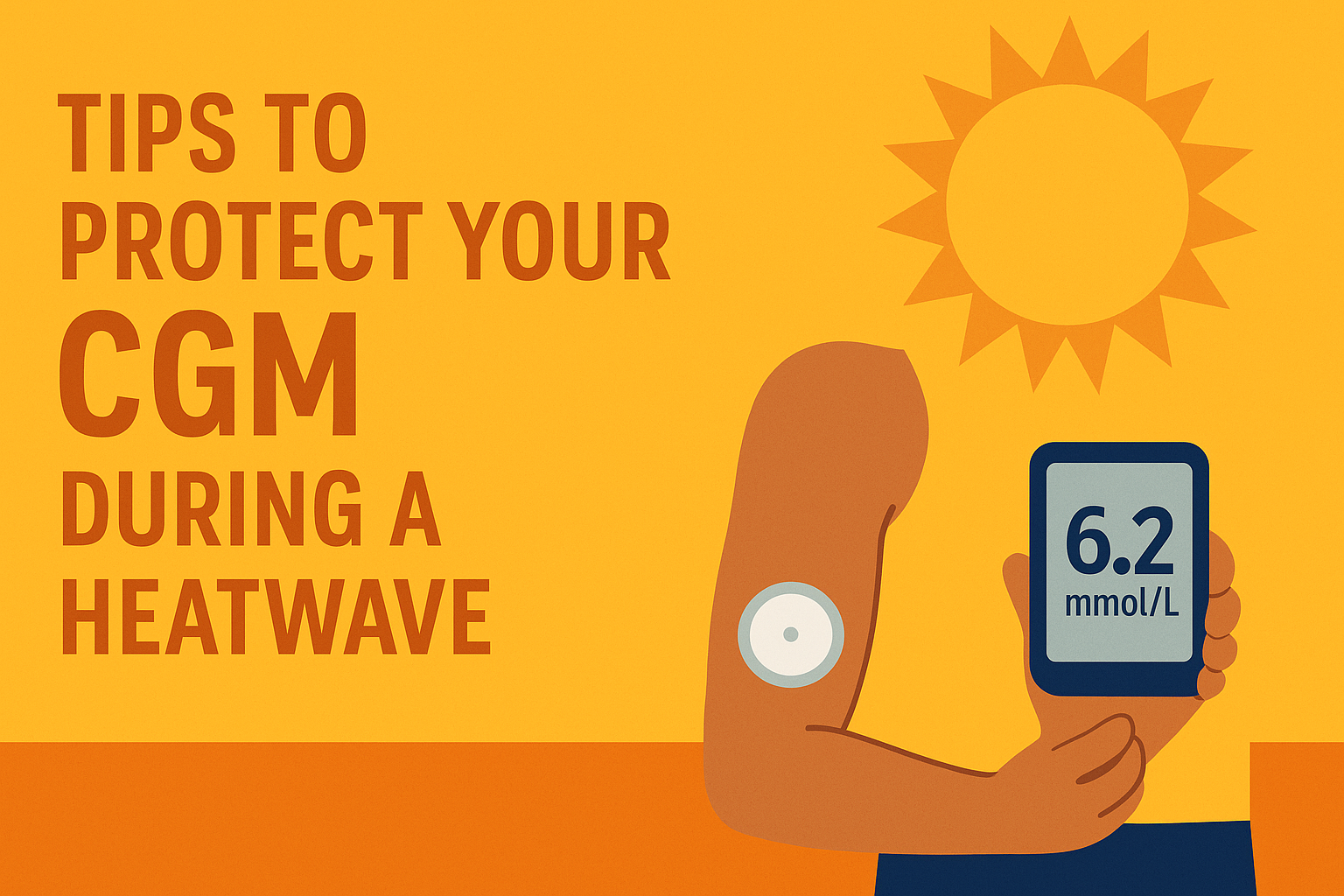Can a CGM go through an airport scanner? And other questions when travelling with diabetes. Answered by a T1D.

With all the excitement of planning and booking a holiday or overseas trip, it's easy to forget that you will need to plan how to manage your diabetes.
If you're not a regular traveller you'll probably have lots of questions and hopefully here you'll find the answers that will help you to enjoy the journey as well as the break once you arrive.
💛💛💛
We start with that question, can a CGM or sensor go through the airport's x-ray machine, or scanner?
At security, you should advise the security personnel that you have diabetes and that you are carrying your supplies onboard. Insulin is allowed to be taken in your hand luggage in any form, be that in vials or pens.
You may need to explain any medical devices attached to you and that these cannot be removed. On occasion, you may need to explain what a CGM is and that the sensor filament is inserted under the skin.
In general, insulin pumps and CGMs (including FreeStyle Libre sensors) should not be screened by x-ray or go through a full body scanner. X-ray waves can cause pumps and CGMs to stop working properly.
Instead, you should ask for an alternative screening method i.e., pat down check on you, and for medical supplies, including any spares you are carrying, ask for them to be hand-checked.
You are recommended to check the manufacturer’s instructions for the particular equipment you use for any specific details for travel and precautions you should take. For UK users the below web pages may be useful.

I also recommend watching this video 'Introducing the Medical Device Awareness Card' from Rachel Crawford. Click here. You can read about Rachel's involvement in developing the card click here.
See below for how to get the card.
Links to manufacturers guidelines
Freestyle Libre: https://www.freestylelibre.co.uk/libre/help.html- look under ‘FAQ’ and ‘Sensor’
Dexcom: https://www.dexcom.com/dexcom-airport-and-travel-guide-flying-dexcom-cgm
Medronic: https://www.medtronicdiabetes.com/customer-support/traveling-with-an-insulin-pump-or-device
GlucoRx AiDEX: https://www.glucorx.co.uk/about-us/faq - see ‘GlucoRx AiDEX™ at airports and scans
Note re Omnipod instructions:
The Omnipod DASH® PDM and Pods can be treated in the same way as the Omnipod® System PDM and Pods at the airport. It is safe to go through the x-ray machine and the Pods are safe to be worn through airport scanners.
source: https://www.omnipod.com/en-gb/current-customers/resources/omnipod-dash-faq
Should I carry diabetes supplies as hand luggage?
It is recommended that you carry insulin, sensors and other medication in your hand luggage, and don’t forget that insulin not currently in use will need to be kept cool so use a Frio bag or similar. [If insulin is packed in checked-in luggage there is a risk that it gets frozen whilst in transit in the hold of the aircraft which could render the insulin useless.]
Most airlines will give you an additional allowance for carrying medical supplies, usually 5 kg.
Note: The NHS suggests that when travelling, a person with diabetes should plan to take twice the amount of medicines and medical supplies that they would normally need.
Read also: Essential guidance for holiday packing – FREE download
Do I need to tell the airline I have diabetes?
Ideally, you should contact the airline you’re travelling with beforehand to discuss any medical devices you need to take onboard. Some airlines require you to notify them of medical equipment and whether you will be carrying needles in advance. You may need to provide additional documentation.
💛💛💛
Do I need a Doctor’s letter for travel?
It is recommended that when travelling you carry a doctor’s letter that confirms your medical condition, how this is treated (ie. if using a pump or injections) and what medications are needed (including use of a sensor if applicable).
Alternatively, you may be able to get a letter from your diabetes care team.
Bear in mind that this letter may be useful in several situations whilst travelling or at your destination, such as at airport security or a pharmacy.
At the airport, it is advisable to keep your Doctor’s letter on you or in your hand luggage.
Read also: Libre Life Spring 2021: Travel issue
What if I need help at the airport?

Many airports in the UK have ‘Hidden Disabilities’ lanyards available at their customer service desks.
The Hidden Disabilities Sunflower is aimed at those with a chronic condition and is intended to enable those persons wearing a special lanyard to be discreetly identified as an individual who may need help or support. The type of support will vary widely and depends on the environment as well as specific needs.
Hidden Disabilities cards can be purchased directly on the website: https://hiddendisabilitiesstore.com
For those who choose to highlight that they have a hidden disability, there are cards available that state ‘I have diabetes’.
It can also be worth considering wearing medical ID that identifies you as having diabetes.
Read also: Identifying a hidden disability
Do I need a medical devices awareness card?
The CAA and the Airport Operators Association (AOA) have produced a Medical Device Awareness Card (see above) for passengers with an insulin pump or CGM.
The Medical Device Awareness Card provides information for both the Security Officer and the passenger.
These can be downloaded and printed at home from the website:
https://www.caa.co.uk - search medical device awareness card
Read also: Medical devices and airport security
Will my sensor work on the plane?
FreeStyle Libre sensors are able to operate as normal whilst flying. However, if you use a Libre reader this should be powered off during take-off and landing.
What about pumps?
The wireless functionality of some insulin pumps and CGM can interfere with aircraft communication and navigation systems, and you may need to remove your CGM and pump whilst in the air if your CGM cannot function without a wireless signal.
You should ensure you have the right equipment to manage your diabetes with an insulin pen in these circumstances and be able to test your glucose by carrying out a finger-prick test.
Pumps should be disconnected at take-off and landing.
Any tips for managing diabetes during the flight?
The air on an aeroplane is often dry and this can lead to dehydration. As glucose levels can be significantly impacted when a person is dehydrated, it is recommended that you ensure you keep up your fluid intake whilst flying and avoid alcoholic drinks.
You should also think ahead in terms of meal times and pack extra snacks in your hand luggage in case of delays, as well as hypos.
Note: On board some airlines, cabin crew may request that your medication is handed over for storage during the flight.
How do I manage changing time zones?
Jet lag can have a significant effect on glucose levels and adjusting your sleep pattern is usually key to minimising this effect.
Many travellers recommend that you adjust your awake/sleep pattern to that of your destination country and you should monitor your glucose levels more frequently. You may need to make ‘corrections’ i.e. extra insulin doses, to ensure you levels don’t fluctuate too much.
Another point to note is that when travelling eastward, your day will feel shorter so less insulin may be needed, whereas when travelling westward you may find the opposite is true.
Thanks for reading. I hope you enjoy your travels!
Disclaimer
Love My Libre is not associated or affiliated with Abbott or FreeStyle Libre. Content here and on our website www.lovemylibre.com does not constitute medical advice or replace the relationship between you and healthcare professionals nor the advice you receive from them.
The author of this blog has type 1 diabetes and uses the FreeStyle Libre 2 which is provided on NHS prescription.
FreeStyle Libre is a registered trademark of Abbott Diabetes Care Inc.





Leave a comment (all fields required). Please note, we are unable to respond to individual comments posted here.